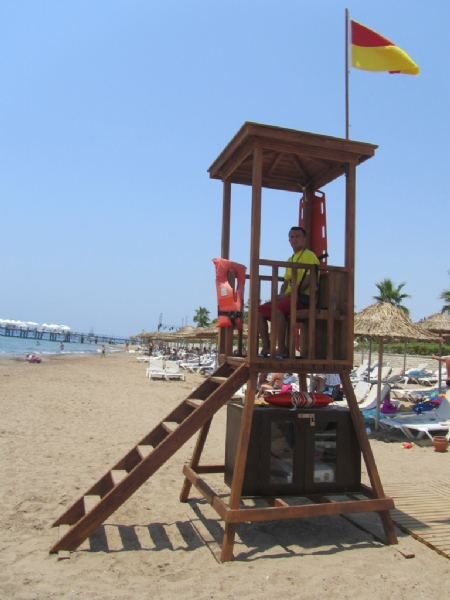
Different beaches (and states) have
different coloured flags and assigned meanings, so be sure to ask the lifeguard
if you’re not sure what the flags signify.
Generally, red flags indicate strong surf
and currents (i.e., “Be Careful!”). At some beaches, red means “beach closed” —
so be sure to check before entering the water. Yellow flags indicate moderate
surf and currents — the water is likely to be rough but not exceedingly
dangerous. Exercise caution and stay near the lifeguards. Green flags indicate
the ocean is calm or clear (though it's always smart to remain alert). Blue or
purple flags often indicate that potentially dangerous marine life (think
sharks or jellyfish) are in the area or have been spotted nearby. Use caution.
And remember: Not all beaches are suitable for swimming, so know the rules
before you set foot on the sand.
Remember how electric devices and the bathtub
don’t mix? Neither do lightning and large bodies of water. Check the weather
report before heading to the beach. Avoid the beach if there’s lightning in the
forecast and wait at least 30 minutes after the last thunder boom before
heading back out to the sand. The beach will always be there tomorrow!
Swimming skills make a big difference: Giving
children aged one to four formal swimming lessons can reduce the risk of
drowning by as much as 88 percent. If you can’t do the doggie paddle (at the
very least), don’t go near the water. Ocean swimming is different from swimming
in a calm pool or lake — be prepared to deal with strong surf before running
in. If you’re at the beach with a child or adult who can’t swim, make sure
everyone has a well-fitting lifejacket handy. If you’re going boating, every
passenger should wear a properly-sized lifejacket at all times.
Also keep in mind that the ocean floor is
not flat and beaches can change drastically from year to year. When heading
into the water, be aware that the ocean floor can drop off unexpectedly, so
don’t move out quickly without being prepared to swim in water over your head.
Last, but certainly not least, obey the
buddy system while swimming. Keep a friend nearby in case either of you ends up
needing help (see section on "rip currents" below).
Lifeguards are there for a reason — they
know and can see things about the beach that most beachgoers don’t. Take note
of where they’re stationed on the beach and stay near them when swimming — most
drownings occur at unguarded sites. Also be aware that currents will naturally
push you down the shore, so make note of where you started (say, by remembering
a stable landmark like the lifeguard’s flag or your brightly-coloured umbrella
on shore) and which way the current is moving. Return to that spot in the water
regularly so you’re never far from a lifeguard.
Rip Tide, Waves don’t always break evenly
along the shore. And when they don’t — i.e., when they break more strongly in
some areas than others — it can cause a circulation in the water that produces
a rip current (basically a strong channel of water extending from the shore out
into the water). Rip currents also tend to form near a shallow point in the
water, such as a sandbar, or close to jetties and piers and can happen at any
beach with breaking waves (including the Great Lakes!). They’re the number one
hazard for beachgoers and can pull even the strongest swimmers out to sea. If
you see a current of choppy, off-coloured water extending from the shore, steer
clear. If you do get pulled out, stay calm, save your energy (let the current
carry you for a while), and keep breathing. Don’t try to swim against the
current! Gain your composure and start swimming horizontal to the shore until
you’re out of the current. Then turn and swim diagonally towards the shore. If
you can’t make it to the shore, wave your arms and make noise so someone can
see or hear you and get help.
They’re much more powerful than you think.
A recent study out of Delaware found that injuries resulting from strong waves
can range from simple sprains, broken collarbones, and dislocated shoulders to
more serious injuries including blunt organ trauma and spinal injuries (which
can lead to paralysis). Shore breaks — or waves that break directly on shore
(rather than breaking a few yards out and rolling in more slowly) — in
particular have the potential to cause serious neck and spinal injuries. When
in the water or near the water line (where the water hits the shore), never put
your back to the waves. Also be sure to check in with the lifeguard before
hitting the surf to ask about the wave conditions at your beach.
Alcohol doesn’t only affect judgment; it
can also dehydrate you, increasing the likelihood of heat-related sicknesses.
Among drowning-related injures of people aged 15 years or older, almost 22
percent were alcohol-related. We know it’s tempting to enjoy a few Pina Coladas
while baking on the beach, but if you’re going to imbibe steer clear of the
surf and hydrate properly.
